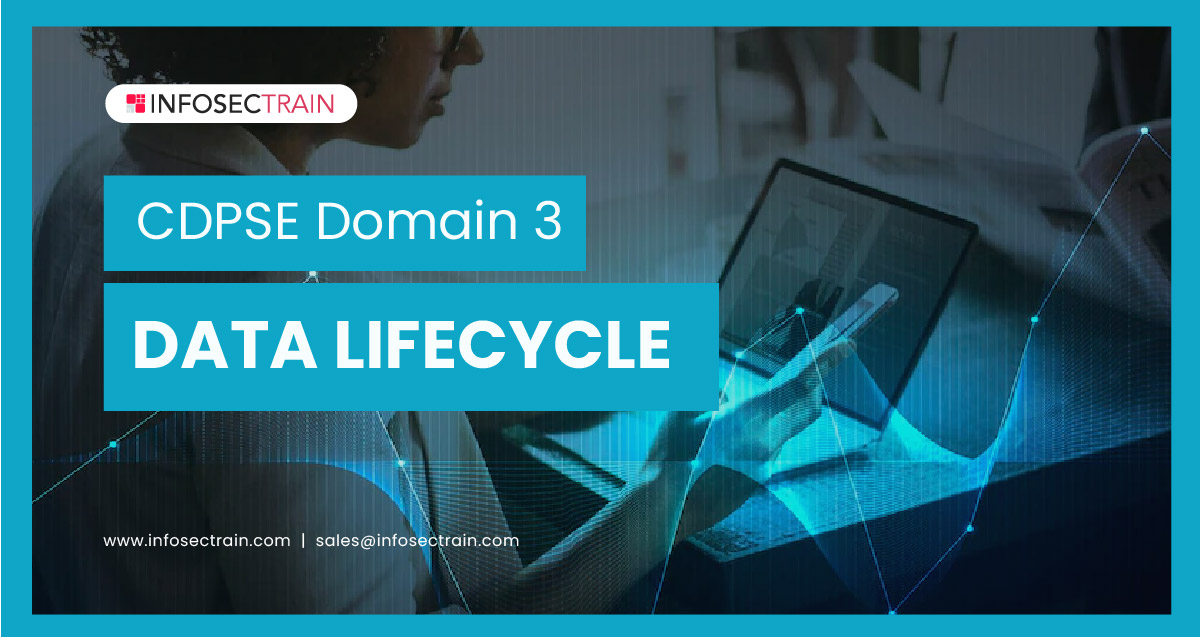ISACA CDPSE Domain 3: Data Lifecycle
ISACA’s CDPSE validates a Data Analyst and Data Scientist’s ability to manage the data lifecycle and guide the organization’s experts on enforcing data protection practices and privacy compliance practices. Data science techniques allow data scientists and privacy experts to enhance the end user’s experience, privacy, and trust. This article is curated to explore and provide an overview of ISACA CDPSE Domain 3, the Data Life Cycle.

Domains of ISACA CDPSE:
The CDPSE exam consists of three domains:
- Domain 1: Privacy Governance (34%)
- Domain 2: Privacy Architecture (36%)
- Domain 3: Data Life Cycle (30%)
Domain 3: Data Life Cycle
The third domain of the ISACA CDPSE covers the remaining 30% of weightage, which includes the data lifecycle components. It focuses on data privacy requirements and applies data privacy controls with best practices. Each phase of the data life cycle includes data storage and how to evaluate adequate data in the organization.
What is the Data Life Cycle?
The Data Life Cycle is a set of phases that help organizations to manage the data flow within the cycle. It is also referred to as the information lifecycle. The Data Life Cycle represents how long the data exists in the system. It is important to understand privacy requirements on organization data to maintain business operations seamlessly.
Data Life Cycle helps to get a clear picture of how the data is stored, transported, and maintained. It also ensures if the data storage requirements abide with the privacy laws and regulations. Organizations process and analyze the collected data for a specific purpose, legally meeting the privacy and collection policies.
Data lifecycle management considers “the right to be forgotten” into account, among other things. If a user requests to discard the data from the system, organizations will discard data from the system adhering to the privacy procedures. The first part of the Domain 3 covers these concepts of the Data Life cycle.
Data privacy and persistence are firmly related, implying that data cannot be collected and stored as undefined. Data has storage requirements based on the data type. Suppose the data consists of personal information such as name, address, phone number, and payment information. In that case, the data storage might include personal information that adheres to the privacy laws. The second part of the Domain 3 covers the concepts of data persistence.
Outline of Domain 3: Data Life Cycle
Part A: Data Purpose
This part of the domain covers the concepts of data purpose, where data is used and processed to meet specific needs. Data enables organizations to get a visual representation of various statistics relating to different variables, and it helps to ensure accuracy and simplifies the data analysis.
- Data Inventory and Classification
- Data Inventory
- Data Classification
- Data Quality and Accuracy
- Data Quality Dimensions
- Dataflow and Usage Diagrams
- Data Lineage
- Data Use Limitation
- Data Analytics
- User Behavior Analytics
Part B: Data Persistence
This part of the domain covers the concept of data persistence, in which data preserves the previous version by itself whenever it is modified. External processes cannot discard the data until and unless the user deletes the data. It allows users to recover data when the system is shut down or restarted.
- Data Minimization
- Data Migration
- Data Conversion
- Refining the Migration Scenario
- Post-Data Migration
- Data Storage
- Data Warehousing
- Extract, Transform, and Load
- Additional Considerations
- Data Retention and Archiving
- Data Destruction
- Data Anonymization
- Deletion
- Crypt-shredding
- Degaussing
- Destruction
Concepts covered in CDPSE Domain 3: Data Life Cycle
Domain 3 of CDPSE covers data privacy and persistence concepts. So, by the end of Domain 3, you will be able to:
- Execute Privacy Impact Assessments (PIA) and other privacy-focused assessments related to the data life cycle.
- Identify the internal and external privacy requirements related to the data life cycle practices.
- Coordinate with other experts to ensure that privacy policies and practices are implemented while designing, developing, and implementing applications, systems, and infrastructure.
- Participate in data life cycle development that meets business requirements and privacy policies.
- Enforce procedures related to the data lifecycle that meets the privacy policies.
- Identify, validate, and implement relevant privacy and security controls based on the data classification procedures.
- Evaluate the information and enterprise architecture to ensure privacy by design principles and data lifecycle considerations are being implemented.
- Design, implement, and monitor data procedures and processes to update the data flow records and checklist.
CDPSE training with InfosecTrain
InfosecTrain is a leading global provider of Information Technology and Cybersecurity training that offers the ISACA CDPSE certification training course. Our well-experienced trainer helps you to get a complete understanding of data privacy and compliance concepts. To know more, check out our CDPSE course and enroll now.




 1800-843-7890 (India)
1800-843-7890 (India) 
